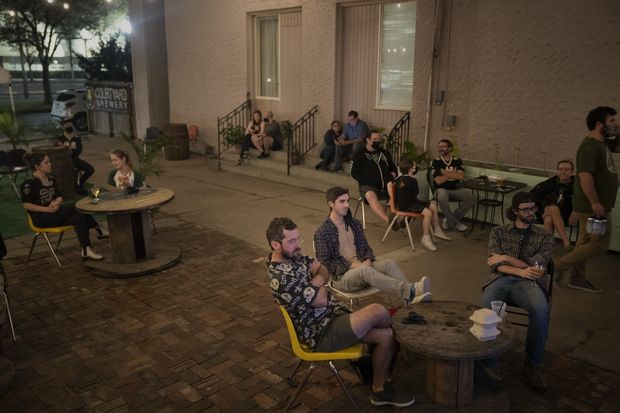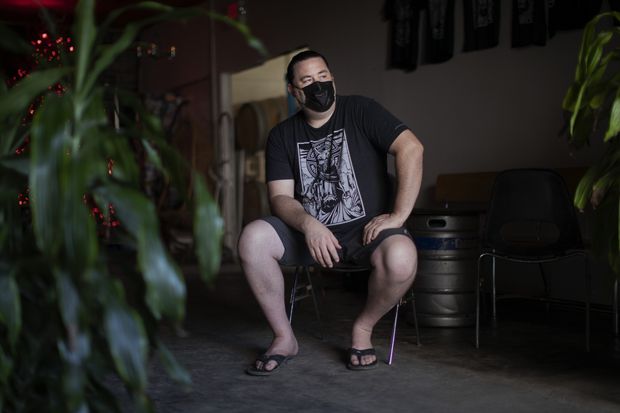Small businesses that cleared the hurdle of the coronavirus shutdowns are now encountering an all-too-familiar obstacle: Banks don’t want to lend to them.
The Paycheck Protection Program funneled $525 billion in forgivable loans to millions of small businesses in the pandemic’s early days. Yet that massive infusion masked a yearslong contraction in small-business lending that happened alongside a big-business borrowing boom.
In 2007, banks held $721 billion in small loans to businesses and small commercial mortgages of $1 million or less, according to an analysis of bank regulatory filings by Florida Atlantic University professor
Rebel A. Cole.
By 2019, such loan balances had fallen around 6% to $680 billion. Bigger business loans and commercial mortgages, meanwhile, more than doubled to $2.82 trillion.
There are a few reasons for the credit chasm. Thousands of community banks disappeared over the past decade, removing the main funding source for many of their local businesses. Small loans are also far less profitable: Bankers say it costs about the same to process an application for a $100,000 loan as it does for a $1 million one.
Lenders have further pulled back during the pandemic, tightening underwriting standards for small businesses this summer to a degree unseen since the last financial crisis, according to a Federal Reserve survey of loan officers.
At
& Co., America’s biggest bank by assets, non-PPP loans to small businesses fell to $956 million in the third quarter, the lowest level since 2010. Nonbank lenders and financial-technology companies, go-to funding sources for small businesses in recent years, have scaled back, too.
PayPal Holdings Inc.
and
Square Inc.
paused new credit offers in the spring and haven’t returned to pre-pandemic lending levels. Kabbage Inc. has yet to make new loans since it sold itself to
American Express Co.
earlier this year.
Scott Wood and his son at the Courtyard Brewery, which was unable to proceed with plans for a new location.
Lenders even curtailed loans made under the Small Business Administration’s traditional lending program, in which the government bears most of the default risk.
Credit can’t save businesses that aren’t viable. But without it, firms that persevered through the pandemic could lack the funding to rehire laid-off workers, preventing the labor market from healing itself and hampering the economic recovery. After the last recession, a lack of credit forced smaller firms to reduce their employment growth by as much as 10.5 percentage points relative to larger ones that had more borrowing options, according to research by Federal Reserve economist
Michael Siemer.
“We’ve never really fixed the access to capital problem to small business,” said Bill Phelan, general manager of PayNet, a division of
Equifax Inc.
that tracks commercial lending. “It probably has been alleviated by PPP, but that won’t last forever.”
It took weeks this spring for the Courtyard Brewery in New Orleans to secure about $34,000 in PPP funds from its bank, JPMorgan. Because of the way the bank processed applications early on, its larger customers had a better chance of getting approved than smaller ones.
Still, it was the most money owner
Scott Wood
had managed to get from JPMorgan in years. The bank repeatedly turned down the brewery’s requests for a higher limit on its small-business credit card. And when Mr. Wood approached the bank about funding an expansion last year, he got nowhere.
Mr. Wood had plans for a new location in the Big Easy’s Mid-City neighborhood—complete with a taproom and restaurant. He lined up investors and a property developer to cover about one-third of the roughly $2 million cost and asked JPMorgan to lend him the rest.
JPMorgan, he said, guided him to apply for an SBA loan since his personal credit score and Courtyard’s income were more than enough to qualify. After months of negotiations, JPMorgan asked Mr. Wood or one of his investors to personally guarantee the entire $2 million project, not just the amount it would finance. Mr. Wood decided not to move forward.
“The bottom line is that unless you come into the game stacked, you’re not playing,” Mr. Wood said.
A JPMorgan spokeswoman declined to comment.
Small businesses employed nearly 61 million people in 2017, or about 47% of the private-sector workforce, according to the most recent data available from the Census Bureau. Despite their importance to the economy, they have long struggled to obtain financing.
Only 35% of small businesses with at least one employee and annual revenue between $100,000 and $1 million had received bank funding in the past five years, according to an April survey of the Federal Reserve’s 12 regional banks. For firms with $100,000 or less in annual revenue, the figure dropped to 24%.
Small businesses have historically turned to small banks for their funding needs. Banks with less than $10 billion in assets held nearly 53% of small loans to businesses at the end of 2017, even though they represented only 17% of all banking-industry assets, according to the Federal Deposit Insurance Corp.’s most recent small-business lending survey.
But consolidation in the banking industry has resulted in many fewer options for companies seeking smaller loans. Between the end of 2007 and September 2020, the number of FDIC-insured banks fell 41% to 5,033.

The Courtyard Brewery has been drawing customers with Saints football games during the pandemic.
Smaller firms tend to keep sparser financial records and have more variable growth trajectories, making them awkward fits for big banks’ bureaucracies, uniform underwriting systems and centralized credit committees.
“The small-dollar loans, which is what Main Street small businesses need, are not financially viable and not center of the plate for” big banks, said
Tammy Halevy,
a senior adviser at Public Private Strategies.
Bank-industry groups also point to postcrisis changes to capital requirements, citing economists’ findings that banks that are subject to the Fed’s annual stress tests reduce some forms of small-business credit significantly more than banks that aren’t.
When policy makers and central banks moved to contain the pandemic’s economic fallout, they focused on shoring up the credit markets that serve bigger businesses. The Federal Reserve and Treasury Department committed up to $750 billion to purchase corporate bonds and syndicated loans, and billions more to support the market for commercial paper, a kind of short-term corporate IOU.
Those measures largely succeeded. Junk-rated companies issued more than $430 billion of speculative-grade bonds between the start of the year and mid-December, a record, according to LCD, a unit of S&P Global Market Intelligence. Companies whose businesses were upended by travel restrictions and stay-at-home orders, such as cruise-line operator
Carnival Corp.
, were only able to sell bonds to investors after the Fed intervened to unclog the market.
The Fed’s tools were less effective in ensuring credit flowed to small businesses.
Few small businesses met the criteria to borrow under the Main Street Lending Program, a $600 billion effort from the Treasury and the Fed to encourage lending to medium-size businesses. Separate Fed facilities targeting PPP loans and securitizations of small-business loans freed up parts of bank and investors’ balance sheets, but that didn’t ultimately result in more new credit being extended to smaller firms.
Fed Chairman
Jerome Powell
told Congress in September that the central bank’s approach of focusing on bond-market interventions allowed it to act quickly where it could be most effective. “The evidence suggests that most creditworthy small and medium-sized businesses can currently get loans from private-sector financial institutions,” he said.

Consolidation in the banking industry has resulted in many fewer options for smaller companies like the Courtyard Brewery.
In the current environment, though, lenders are finding it more difficult to assess the creditworthiness of small businesses when traditional measures, like a prior year’s tax filings or an owner’s credit score, have less predictive power.
Small-business credit-card and commercial-loan balances at
Bank of America Corp.
, excluding PPP loans, were about 8% lower at the end of September than they were at the end of 2019, despite lower default rates, according to securities filings. The bank’s SBA lending, excluding PPP and other disaster loans, is running 30% below where it was this time last year, Chief Executive
Brian Moynihan
said at a conference earlier this month.
“You had to tighten in the middle of the crisis,” he said.
& Co. halved its credit line to
Rishi Khanna’s
software-outsourcing company during the last financial crisis. ISHIR Inc.’s borrowing limit has barely budged since, despite annual revenue that is now orders of magnitude more than his roughly $29,000 credit line.
SHARE YOUR THOUGHTS
Will a second round of Paycheck Protection loans be able to stabilize small businesses? Why or why not? Join the conversation below.
A $45,000 PPP loan got the company through the pandemic’s early months. When business picked up in the fall, Mr. Khanna approached Wells again about increasing the credit line. New clients wanted as long as 90 days to pay ISHIR’s invoices. He needed a loan to bridge the gap and, potentially, to hire more workers.
Wells declined his request, as did JPMorgan, with which ISHIR also had a credit line. Mr. Khanna turned to the Texas community bank that helped ISHIR secure the PPP loan. He said he was told the bank was too busy processing PPP forgiveness applications to entertain new credit requests.
Wells Fargo makes “every direct loan we responsibly can to support customers’ credit needs,” a spokesman said in an email. JPMorgan declined to comment.
Banks’ treatment of ISHIR “hasn’t been bothering me until the pandemic,” Mr. Khanna said. “Now I need my help. Where are you?”

Scott Wood, owner of the Courtyard Brewery.
Write to Peter Rudegeair at Peter.Rudegeair@wsj.com
Copyright ©2020 Dow Jones & Company, Inc. All Rights Reserved. 87990cbe856818d5eddac44c7b1cdeb8






